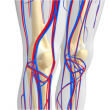Everybody keeps wondering whether drug-coated balloons can actually increase mortality. If that is the case, there is an even harder question in need of an answer: what would be the physiopathology for such increase in mortality? As a lukewarm message, the US Food and Drug Administration recommended a special informed consent form when these devices...
Is Complete Revascularization the Right Choice in Acute Myocardial Infarction with Multivessel Disease?
Courtesy of Dr. Carlos Fava. Primary coronary angioplasty has been the treatment of choice for acute myocardial infarction (MI) for many years, but such strategy is associated with nonculprit lesions in a large group of patients. While it has been proven that nonculprit-lesion revascularization offers better outcomes, the groups that would benefit from it are...
What Happens When We Are Blinded by Left Main Disease and Ignore All Other Lesions?
According to this recent Excel analysis, mortality seems to rise when the SYNTAX II score is not taken into account when defining the revascularization strategy. The difference does not reach statistical significance and further studies are required, but the message is clear: the left main coronary artery is not the only thing that matters; other...
EXCEL Outcomes: PCI vs CABG in Patients with Prior Cerebrovascular disease
Most certainly, as we read this title, we imagine the conclusion (as does the editor): patients with prior cerebrovascular disease (CEVD) benefit from a less invasive revascularization strategy, such as PCI. However, the EXCEL outcomes tell us that patients with left main coronary artery disease (LMCAD) and a history of CEVD will not benefit from...
DES and DCB with Similar Results in Femoropopliteal Artery Disease
Courtesy of Dr. Carlos Fava. Nowadays, peripheral interventions are on the rise and the technological development of stents and balloons would help achieve better outcomes. Both drug-eluting stents (DES) and drug-coated balloons (DCB) have proved to be beneficial for femoropopliteal interventions, but the actual role of each of these technologies remains unclear. This prospective, randomized 1:1...
FDA Alert on Drug-Coated Balloons and Stents in Femoropopliteal Artery Disease
The US Food and Drug Administration (FDA) has issued an alert on the potential long-term risk of paclitaxel-coated balloons and paclitaxel-eluting stents in patients with femoropopliteal artery disease. This agency is evaluating signals of increased long-term deaths among patients with femoral or popliteal artery disease treated with paclitaxel-coated devices in a recent study. In...
The Most Relevant Articles of 2018 in Peripheral Vascular Disease
1- What’s New in the European Guidelines on Peripheral Arterial Disease Since the last version of the European guidelines on the diagnosis and treatment of peripheral arterial disease in 2011, there have been many trials and registries that warrant guideline adjustments in many aspects. The first novelty is the teamwork that gave way to these...
What’s New in the European Guidelines on Peripheral Arterial Disease
Since the last version of the European guidelines on the diagnosis and treatment of peripheral arterial disease in 2011, there have been many trials and registries that warrant guideline adjustments in many aspects. The first novelty is the teamwork that gave way to these guidelines, which were written in collaboration with the European Society of...
What is the effect of statins on amputations, and survival in peripheral vascular disease?
The prevalence of peripheral arterial disease is between 15% and 20% of patients older than 65 years and its severity is greatly underestimated. In fact, annual mortality is higher in patients with peripheral arterial disease (8.2%) than in those after acute myocardial infarction (6.3%). Despite the above, medical advice and efforts to modify risk factors...
CLACE 2018: Latin American Congress on Structural Heart Disease
The 10th edition of the Latin American Congress on Structural Heart Disease (CLACE, its acronym in Spanish), founded by Dr. Antonio Enrique Dager Gómez, will take place from April 25th to April 27th in Cali, Colombia. This event addresses several cardiovascular topics (hemodynamics, endovascular intervention for peripheral vascular disease, coronary artery disease and related advancements, endovascular...









